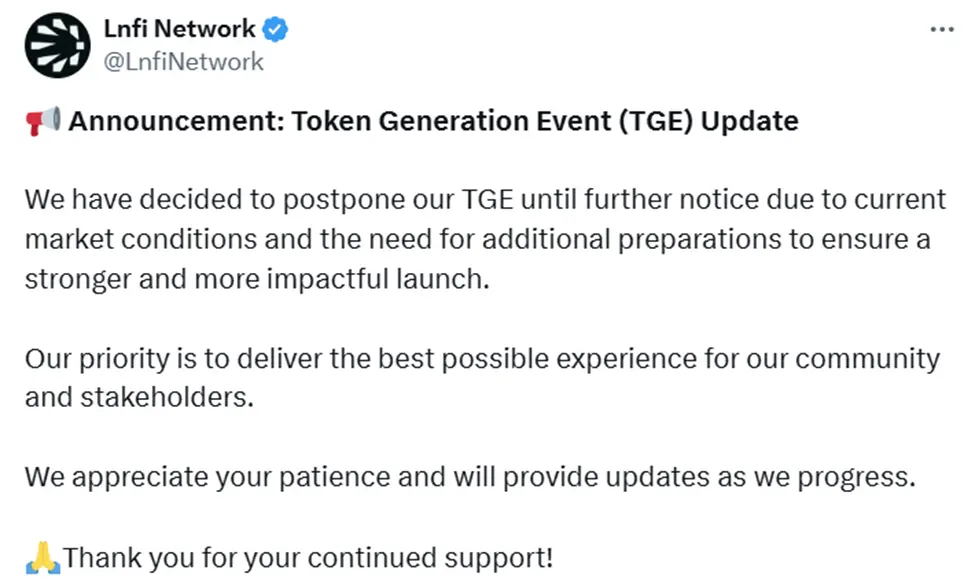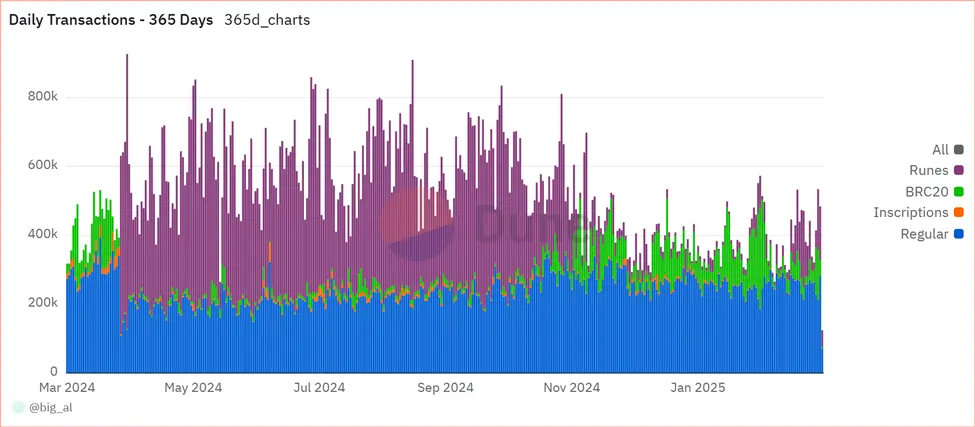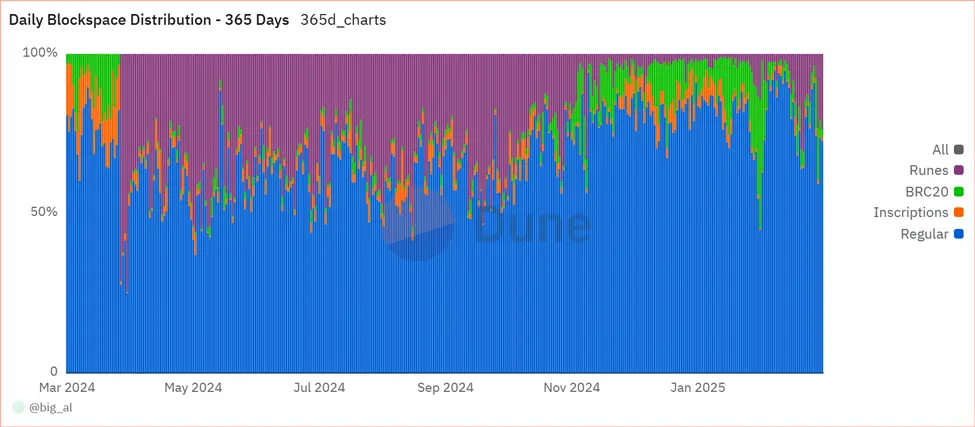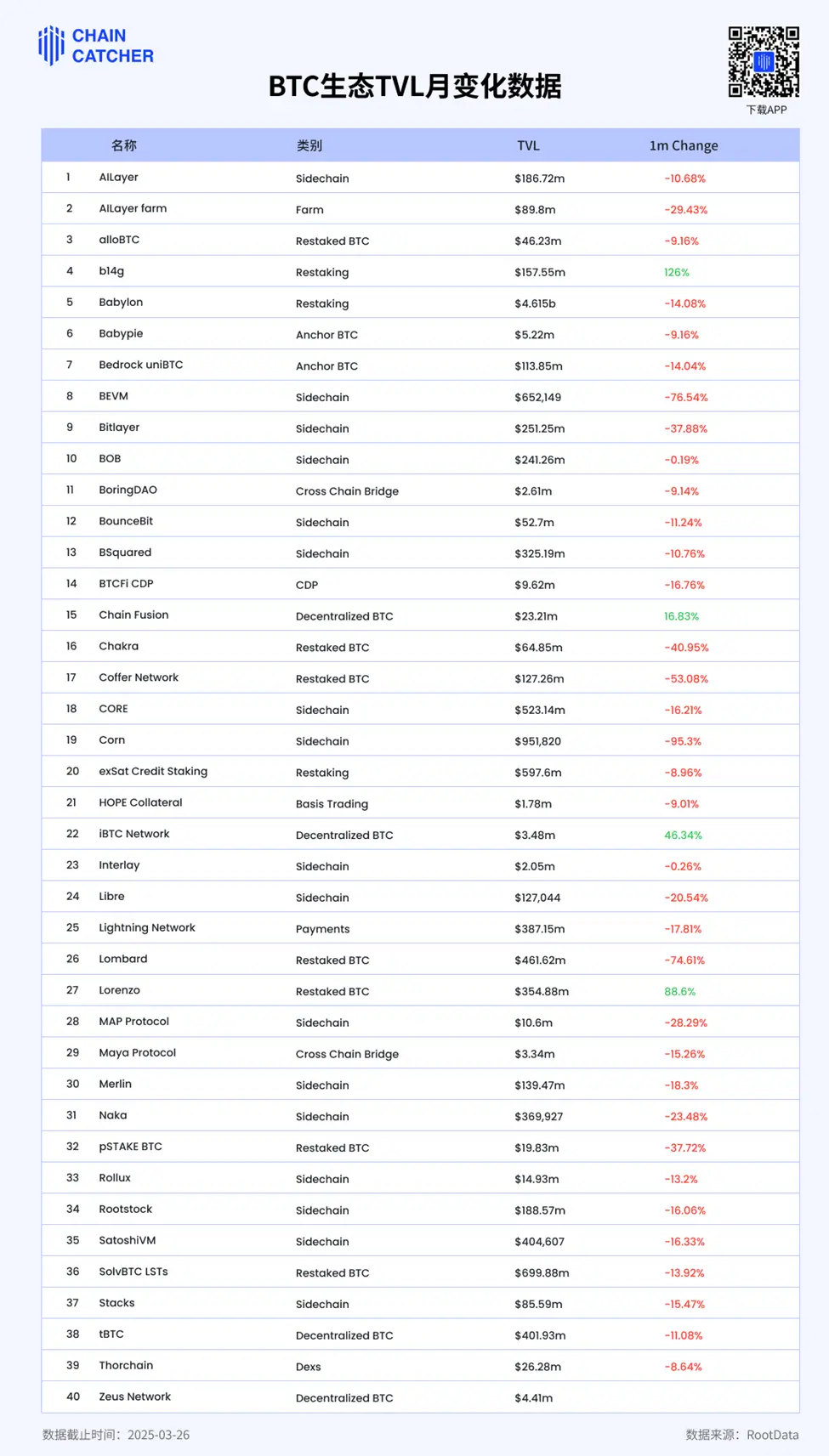The dilemma of the BTC ecosystem community under market cycles, technical bottlenecks, and a lack of trust.
Written by: 0xLayman, ChainCatcher
On March 24, 2025, Lnfi Network announced the postponement of its TGE, following previous delays in releasing its core products.
Looking at the current state of BTC ecosystem projects, the delay of Lnfi Network is a microcosm of the entire ecosystem's dilemma under market fluctuations and industry fatigue.

The Trust Crisis Behind the Delay
Lnfi Network (formerly NostrAssets), as a BTC Layer 2.5 solution, aims to introduce Web3 and tokenization into the Lightning Network, launching corresponding DeFi solutions.
However, the project did not provide clear details regarding the specific time for the restart, additional preparations needed, or compensation plans for early participants, only stating "market conditions are poor."
It is noteworthy that as early as August 7, 2024, the project team had postponed the release of its core products LN Bridge and LN Exchange for the same reason of "market downturn."
In an environment where the development of the BTC ecosystem is generally slow and investor sentiment is increasingly cautious, Lnfi Network's behavior of "repeated delays with vague reasons" inevitably further erodes community trust. Even though it previously attracted seed round investments from institutions like HashKey Capital, UTXO Management, CMS Holdings, and Waterdrip Capital, this is insufficient to mask discussions within the community regarding the project team's lack of execution and untimely information disclosure.
Discrepancy Between Vision and Reality
Although the market seemed to show signs of recovery at the end of March, the awkward position of BTC ecosystem projects like Lnfi Network may be a deeper reason for its further postponement of the TGE.
In the latter half of this market upcycle, the focus has shifted more towards short-term speculative assets like memecoins, which has further weakened the overall attractiveness of the Bitcoin ecosystem and made the long-term DeFi vision of projects like Lnfi Network seem out of sync with the current market atmosphere.


According to public data from Dune, as of March 24, 2025, the daily transaction volume of the BTC ecosystem reached approximately 483,600 transactions, with regular BTC transfers accounting for about 281,400 transactions, or 58.2%; the daily transaction volume of the Runes protocol was about 156,800 transactions, or 32.4%; the daily transaction volume of BRC20 tokens was about 44,600 transactions, or 9.2%; and the daily transaction volume of Inscriptions was only 807 transactions, or 0.2%.
Compared to the peak daily transaction volume of over 1 million transactions during the same period last year (with the Runes protocol reaching a daily high of over 600,000 transactions), the current overall transaction volume of the BTC ecosystem has significantly declined, down about 53% year-on-year.
Specifically, the transaction volume of the Runes protocol has dropped sharply from about 600,000 transactions per day during the peak in 2024 to the current approximately 156,800 transactions, a decline of over 70%. Although BRC20 tokens once saw a surge in transaction volume driven by the memecoin craze, the recent average daily transaction volume has remained in the range of 40,000 to 50,000 transactions, failing to sustain the overall ecosystem's activity. Inscriptions-related transactions have nearly disappeared, accounting for a tiny fraction of total transaction volume (less than 1%).
Overall, on-chain transactions in the Bitcoin ecosystem have largely reverted to being dominated by regular BTC transfers, reflecting a market that is gradually returning to rationality after experiencing a brief memecoin and emerging protocol frenzy, with speculative trading activities significantly reduced.
Shared Ecological Dilemma
The predicament of Lnfi Network is not an isolated case; its TGE delay also reflects the common challenges faced by the entire BTC ecosystem.
Although Layer 2 and related solutions were once highly anticipated by the market to enhance the scalability and functionality of the Bitcoin network, the path to technological breakthroughs remains fraught with challenges: some DeFi protocols have increased ecological complexity, requiring a balance between security and usability; the Lightning Network may face liquidity shortages and centralization risks; while Layer 2 solutions have improved scalability, they still face challenges in achieving high throughput, low fees, and ensuring bridging security and user-friendliness.
BTC ecosystem projects are not only constrained by technical bottlenecks and market fluctuations but also face trust issues from users and the community. After years of market development, users have become more cautious about new projects.
In the context of an increasing number of projects and frequent delays, even if institutional funds continue to flow in to drive market capitalization growth, the pace of investor participation is slowing. Compared to investing in higher-risk BTC sidechains or DeFi projects, investors are more inclined to hold Bitcoin to seek stable returns from price increases.

According to incomplete statistics from ChainCatcher, the vast majority of projects in the BTC ecosystem have shown negative growth in monthly TVL changes. This indicates that the overall capital inflow situation of BTC ecosystem projects is not optimistic, generally presenting a trend of negative growth.
Even though the BTC ecosystem still possesses inherent consensus advantages, if it cannot find a balance between the implementation of new technologies and user trust, then many projects, including Lnfi Network, may further sink in the midst of market fluctuations and industry fatigue.
免责声明:本文章仅代表作者个人观点,不代表本平台的立场和观点。本文章仅供信息分享,不构成对任何人的任何投资建议。用户与作者之间的任何争议,与本平台无关。如网页中刊载的文章或图片涉及侵权,请提供相关的权利证明和身份证明发送邮件到support@aicoin.com,本平台相关工作人员将会进行核查。




